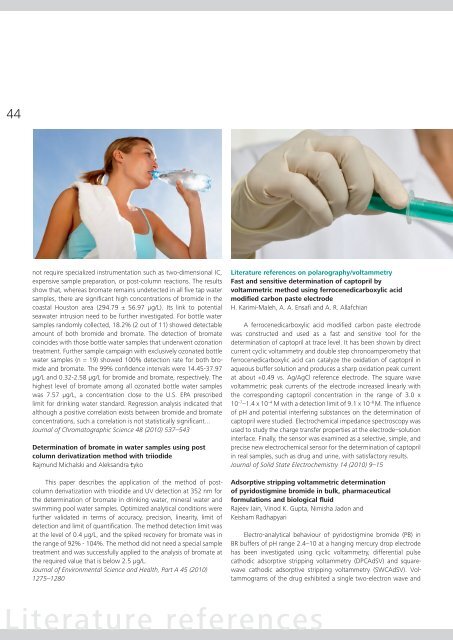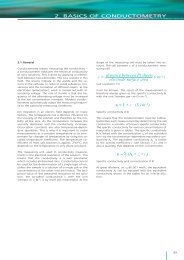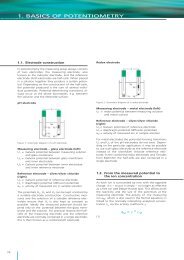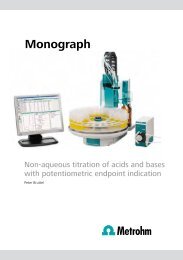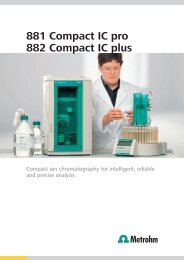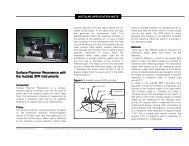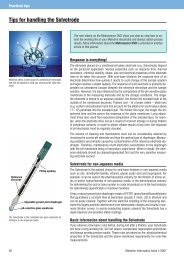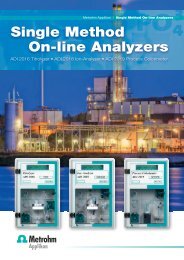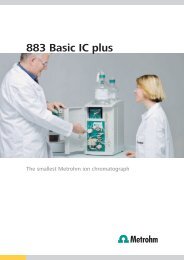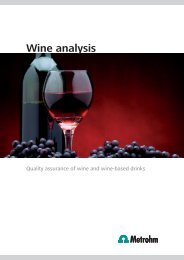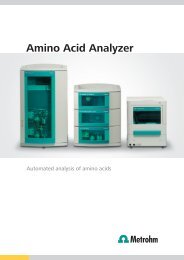Download (PDF) - Metrohm
Download (PDF) - Metrohm
Download (PDF) - Metrohm
You also want an ePaper? Increase the reach of your titles
YUMPU automatically turns print PDFs into web optimized ePapers that Google loves.
44not require specialized instrumentation such as two-dimensional IC,expensive sample preparation, or post-column reactions. The resultsshow that, whereas bromate remains undetected in all five tap watersamples, there are significant high concentrations of bromide in thecoastal Houston area (294.79 ± 56.97 µg/L). Its link to potentialseawater intrusion need to be further investigated. For bottle watersamples randomly collected, 18.2% (2 out of 11) showed detectableamount of both bromide and bromate. The detection of bromatecoincides with those bottle water samples that underwent ozonationtreatment. Further sample campaign with exclusively ozonated bottlewater samples (n = 19) showed 100% detection rate for both bromideand bromate. The 99% confidence intervals were 14.45-37.97µg/L and 0.32-2.58 µg/L for bromide and bromate, respectively. Thehighest level of bromate among all ozonated bottle water sampleswas 7.57 µg/L, a concentration close to the U.S. EPA prescribedlimit for drinking water standard. Regression analysis indicated thatalthough a positive correlation exists between bromide and bromateconcentrations, such a correlation is not statistically significant...Journal of Chromatographic Science 48 (2010) 537–543Determination of bromate in water samples using postcolumn derivatization method with triiodideRajmund Michalski and Aleksandra LykoThis paper describes the application of the method of postcolumnderivatization with triiodide and UV detection at 352 nm forthe determination of bromate in drinking water, mineral water andswimming pool water samples. Optimized analytical conditions werefurther validated in terms of accuracy, precision, linearity, limit ofdetection and limit of quantification. The method detection limit wasat the level of 0.4 µg/L, and the spiked recovery for bromate was inthe range of 92% - 104%. The method did not need a special sampletreatment and was successfully applied to the analysis of bromate atthe required value that is below 2.5 µg/L.Journal of Environmental Science and Health, Part A 45 (2010)1275–1280Literature references on polarography/voltammetryFast and sensitive determination of captopril byvoltammetric method using ferrocenedicarboxylic acidmodified carbon paste electrodeH. Karimi-Maleh, A. A. Ensafi and A. R. AllafchianA ferrocenedicarboxylic acid modified carbon paste electrodewas constructed and used as a fast and sensitive tool for thedetermination of captopril at trace level. It has been shown by directcurrent cyclic voltammetry and double step chronoamperometry thatferrocenedicarboxylic acid can catalyze the oxidation of captopril inaqueous buffer solution and produces a sharp oxidation peak currentat about +0.49 vs. Ag/AgCl reference electrode. The square wavevoltammetric peak currents of the electrode increased linearly withthe corresponding captopril concentration in the range of 3.0 x10 –7 –1.4 x 10 –4 M with a detection limit of 9.1 x 10 –8 M. The influenceof pH and potential interfering substances on the determination ofcaptopril were studied. Electrochemical impedance spectroscopy wasused to study the charge transfer properties at the electrode–solutioninterface. Finally, the sensor was examined as a selective, simple, andprecise new electrochemical sensor for the determination of captoprilin real samples, such as drug and urine, with satisfactory results.Journal of Solid State Electrochemistry 14 (2010) 9–15Adsorptive stripping voltammetric determinationof pyridostigmine bromide in bulk, pharmaceuticalformulations and biological fluidRajeev Jain, Vinod K. Gupta, Nimisha Jadon andKeisham RadhapyariElectro-analytical behaviour of pyridostigmine bromide (PB) inBR buffers of pH range 2.4–10 at a hanging mercury drop electrodehas been investigated using cyclic voltammetry, differential pulsecathodic adsorptive stripping voltammetry (DPCAdSV) and squarewavecathodic adsorptive stripping voltammetry (SWCAdSV). Voltammogramsof the drug exhibited a single two-electron wave andLiterature references


